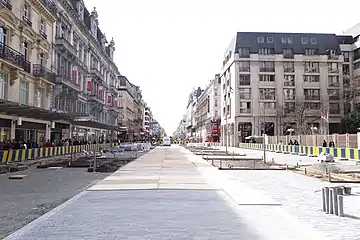Boulevard Anspach
Boulevard Anspach (French) or Anspachlaan (Dutch) is a central boulevard in Brussels, Belgium, connecting De Brouckère Square to Fontainas Square. It bears the name of a former mayor of the City of Brussels, Jules Anspach (1829–1879). Many places of interest lie along Boulevard Anspach, for instance the Brussels Stock Exchange, the Ancienne Belgique concert hall, the Palace cinema, as well as numerous shops and restaurants.
 View along Boulevard Anspach from De Brouckère Square | |
 Location within Brussels | |
| Location | City of Brussels, Brussels-Capital Region, Belgium |
|---|---|
| Quarter | Central District |
| Coordinates | 50°50′52″N 04°20′57″E |
| Construction | |
| Completion | 1868–1871 |
Boulevard Anspach is continued to the north by both Boulevard Emile Jacqmain/Emile Jacqmainlaan and Boulevard Adolphe Max/Adolphe Maxlaan, forming a "Y" crossroad. To the south, it crosses the Place de la Bourse/Beursplein about halfway through, and continues towards Fontainas Square where it becomes Boulevard Maurice Lemonnier/Maurice Lemonnierlaan.
De Brouckère metro station on lines 1 and 5 of the Brussels metro is accessible from Boulevard Anspach, as well as the Bourse/Beurs premetro (underground tram) station.
History

Boulevard Anspach was built between 1868 and 1871 over the river Senne, covering it up, although the river no longer runs underneath it. Prior to 1879, it was named Boulevard Central/Centraallaan ("Central Boulevard"),[1] when it was renamed in honour of Jules Anspach (1829–1879), the former mayor of the City of Brussels who instigated these works.
On 4 September 1944, Boulevard Anspach was the scene of great jubilation during the liberation of Brussels by the British Guards Armoured Division. In 1976, as part of the North–South line, the premetro took the place of the river, which was then diverted along the small ring road.
Since 29 June 2015, the boulevard has been pedestrianised between the Place de la Bourse/Beursplein and De Brouckère Square as part of a broader pedestrianisation of Brussels' city centre.[2][3][4]
Notable buildings
- No. 3: Café Sésino (1875) by Désiré De Keyser. This building won the fifth prize in the architectural competition of 1876. It was demolished in 1967.
- No. 56–58: Built in 1939 by Adrien Blomme for Wielemans-Ceuppens breweries. It once housed the famous café Aux Armes des Brasseurs.[5]
- No. 59–61: Eclectic apartment building (1872) by Gédéon Bordiau, decorated with caryatids by sculptor Julien Dillens[6]
- No. 78: Neo-Baroque apartment building (1874) by Émile Janlet[7]
- No. 85: Pathé Palace cinema (1913) by Paul Hamesse[8]
 Café Sésino, De Keyser (1875) (demolished)
Café Sésino, De Keyser (1875) (demolished) Aux Armes des Brasseurs, Blomme (1939)
Aux Armes des Brasseurs, Blomme (1939) Apartment building, Bordiau (1872)
Apartment building, Bordiau (1872) Apartment building, Janlet (1874)
Apartment building, Janlet (1874) Pathé Palace cinema, Hamesse (1913)
Pathé Palace cinema, Hamesse (1913)
See also
| Wikimedia Commons has media related to Boulevard Anspach/Anspachlaan, Brussels. |
References
- http://www.ebru.be/Streets/bruxelles-1000-boulevard-anspach.html
- O'Sullivan, Feargus (7 January 2014). "Europe's Most Congested City Contemplates Going Car-Free". City Lab. The Atlantic. Retrieved 9 February 2015.
- Vermeersch, Laurent (6 February 2015). "Centrale lanen: twee fonteinen en twee fietsparkings" (in Dutch). Brussel Nieuws. Retrieved 9 February 2015.
- "Project. Pedestrian zone". www.brussels.be. 2017-02-28. Retrieved 2018-12-15.
- "Bruxelles Pentagone - Boulevard Anspach 56-58 - BLOMME A." www.irismonument.be. Retrieved 2018-12-20.
- "Bruxelles Pentagone - Boulevard Anspach 59-61 - Rue du Marche aux Poulets 16-18-20 - BORDIAU Gedeon". www.irismonument.be. Retrieved 2018-12-20.
- "Bruxelles Pentagone - Boulevard Anspach 76-78 - Rue de la Bourse 2 - JANLET E." www.irismonument.be. Retrieved 2018-12-20.
- "Bruxelles Pentagone - Pathe Palace - Boulevard Anspach 85-87 - Borgval 19-21-23 - Rue Jules Van Praet 24-26-28 - HAMESSE Paul". www.irismonument.be. Retrieved 2018-12-20.
| Wikimedia Commons has media related to Boulevard Anspach/Anspachlaan, Brussels. |